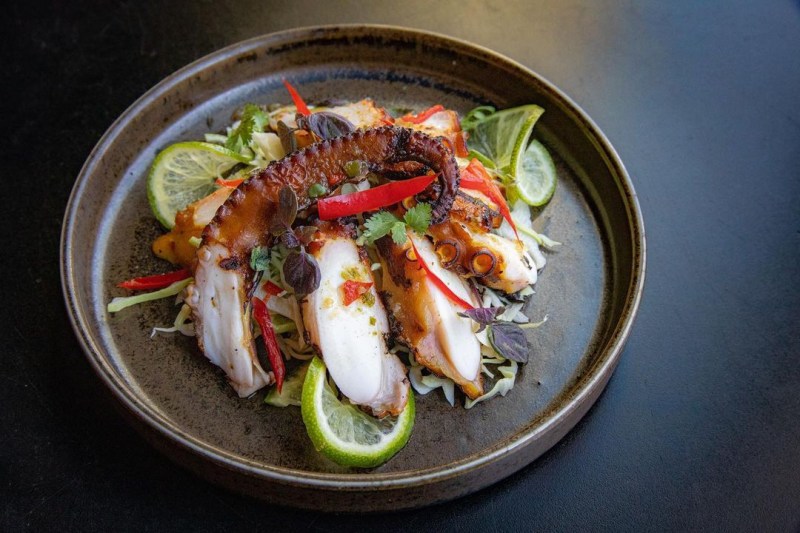
A vibrant combination of sweet, spicy, and sour, Thai cuisine is one of the most dynamic in the world. While the cuisine is incredibly popular in America, the richness of Thai food goes far beyond standard takeout orders of Pad Thai and chicken satay.
Like the adaptions of Chinese American food (General Tso’s chicken and crab rangoon), American Thai cuisine can be quite different from its Thailand counterparts. For example, Pad Thai is a relatively modern dish, created in the 1930s and far less popular in Thailand than America.
However, Thai cuisine is seeing a revolution in America. Like other international cuisines gaining popularity, a younger generation of Thai American chefs are combining both innovation and regional specialization, pushing their cuisine to new heights.
History and culinary influences

Historically, Thailand has been a dominant power in Southeast Asia and the only nation in the region that was never colonized by the Europeans. The Thai monarchy, an institution with eight hundred years of history, remains an important element in the country.
Thailand’s location in Southeast Asia gives the cuisine a diverse array of influences. One of the biggest influences is China, stemming from centuries of Chinese migration and trade in Thailand. Chinese immigrants were instrumental in bringing several culinary influences, including stir-frying, Cantonese-style barbecued meats, Chinese spices like star anise, and street food culture.
The four regions of Thai cuisine

To understand Thai cuisine, its important to grasp its diversity. Thai food can vary greatly depending on region, appearing at times like a completely different cuisine. There are four regional cuisines in Thailand, each with its own unique flavors and ingredients.
Central Thailand
This region is often considered the cultural center of Thailand. Most of the country’s ethnic Buddhist Thais live in this region along with the Thai royal family. Jasmine rice is the staple food here and the cuisine has a strong Chinese influence, evidenced in the stir-fried dishes, Chinese style barbecued meats, and rice noodles popular in this region.
Northeastern Thailand (Isan)
Sticky rice, steamed and eaten by hand, is the preferred starch here. Most people in this region are ethnic Lao or Khmer and the food has strong influences from those cultures. Grilled meats and strong fermented flavors are predominant here. The famous green papaya salad (som tum) is an Isan specialty. In recent years, Isan cuisine has increased in popularity in America, as evidenced by the popular Thai restaurants Pok Pok and Hug Isan.
Northern Thailand
Along the Burmese and Lao border, this Northern Thai region is a mountainous jungle, producing a cuisine that emphasizes strong herbs, meat, and freshwater fish. Like Isan, sticky rice is the staple here. A famous dish from this region is laap, a diced meat salad made with meat, offal, herbs, fried garlic, shallots and spices.
Southern Thailand
Encompassing the peninsula on the border of Malaysia, Southern Thai cuisine is the spiciest in the country. The population in this region is majority Muslim Malay. Southern Thai cuisine relies heavily on coconuts, using the fruit in both savory curries, soups, and sweets. Surrounded by the ocean, seafood is also common, usually served with a hearty amount of jasmine rice, the preferred starch of Southern Thais.
Staple dishes

Although rice is the staple food, noodles are also widely eaten. The most popular noodles are rice-based like the startlingly pink yen ta fo, a flat rice noodle soup made pink by fermented bean curd. Or nam tok, a dish of thin rice noodles in a broth enriched by beef or pork blood. Stir fries and curries are everywhere in Thailand and served with steaming plates of jasmine rice or balls of sticky rice meant to be dipped. A common misconception about Thai cuisine is the use of chopsticks. Thais generally only use chopsticks for noodles. Instead, the simultaneous use of a fork and spoon is the common way to eat rice and other dishes.
A major part of Thai cuisine is street food. In Bangkok, a dizzying array of street food vendors populate every corner of the city, serving everything from noodles to grilled meats. This street food culture has produced a unique eating culture in Thailand, as Thais are famous for eating several small meals a day.
Thai cuisine is famous for its blend of flavors. Sweetness is added with palm sugar or si io dam, a thick, sweet soy sauce. Limes and tamarinds add sourness. For savory umami, Thai fish or soy sauce comes into play. For the best result, it’s important to use Thai soy sauce when cooking Thai dishes as it tends to be sweeter than Chinese or Japanese versions. If possible, obtain a Thai brand, like Healthy Boy, when attempting a recipe. A Thai table will also contain condiment jars filled with dried chili flakes, sugar, chilies in vinegar, and other seasonings for individual diners to adjust their dish to taste.
Thai cuisine in America

Although the majority of American Thai restaurants might heavily feature dishes like Pad Thai or drunken noodles, new Thai restaurants in America attempting to change this perception.
Tong, a Brooklyn restaurant, is bringing a unique Thai specialty to America — Thai-style drinking food. “We were thinking of how we eat in Thailand when we go out, when we drink, we eat,” said Prasneeya “Pat” Praditpoj, one of Tong’s partners. “We like to have a good time with friends and share small dishes.” At Tong, these dishes include grilled pork jowl with a spicy dipping sauce, raw oysters with Thai chili jam and naem khluk, crispy rice with fermented pork sausage and chilies.
Popular Thai dishes in the U.S.
Several Thai food dishes are popular in the U.S. We’ve already mentioned Pad Thai, so here are some other popular menu items.
Tom Yum Goong: This spicy and sour shrimp soup is a staple of Thai cuisine. It’s made with a fragrant broth flavored with lemongrass, galangal, kaffir lime leaves, chilies, lime juice, and fish sauce. It’s usually served with shrimp, mushrooms, straw mushrooms, and tomatoes.
Green curry: This curry dish is known for its vibrant green color, which comes from green chilies, herbs, and spices. It’s usually made with coconut milk, vegetables like bamboo shoots and green beans, and protein like chicken, beef, or tofu.
Pad See Ew: This stir-fried noodle dish is made with wide rice noodles, vegetables like broccoli and carrots, and protein like chicken, pork, beef, or tofu. It’s typically stir-fried in a savory soy sauce-based sauce.
Thai fried rice: This is a general term for any type of fried rice dish made with Thai ingredients. It can be made with vegetables, meat, seafood, or eggs.
Pad Kra Pao Gai (Thai basil chicken)

(By Mark Wiens, author of eatingthaifood.com)
This recipe is adapted from eatingthaifood.com, a Thai food website run by Bangkok-based food YouTuber Mark Wiens. This stir-fried dish is extremely popular. Serve with a fried egg on top for a true Thai classic.
Ingredients:
- 8 ounces chicken breast, diced or ground chicken (preferably dark meat)
- 5 cloves of garlic
- 4 Thai chilies
- 1 tablespoon of oil for cooking
For the sauce:
- 1 teaspoon of oyster sauce
- 1/2 teaspoon of light soy sauce (Thai brand)
- 1/2 teaspoon of dark soy sauce
- 1/2 teaspoon of sugar
- 1 handful of Thai holy basil (can substitute with Thai sweet basil, although the peppery flavor of holy basil will not be replicated by the anise-like sweetness of Thai sweet basil)
Method:
- If not using ground chicken, cut the chicken breast into bite-sized pieces.
- Pound garlic and chilies with a mortar and pestle into a chunky paste. If a mortar is not available, mince with a knife.
- Heat a wok or pan on high heat. Add oil.
- When the oil is hot, add the chilies and garlic. Stir fry for about 20 seconds or until fragrant. Do not let them burn.
- Add chicken and stir continuously. Cook until chicken is almost fully cooked, about 2 to 3 minutes. If the pan appears dry, add a small splash of water.
- With the chicken still in the pan, add all sauce ingredients and stir fry for another 30 seconds.
- Toss a handful of holy basil into the pan and mix with the chicken. Immediately turn off the heat. Cooking the basil for too long ruins the flavor. Serve with hot jasmine rice and a fried egg on top.
Thai fried bananas

(By Pailin Chongchitnant, author of Hot Thai Kitchen)
This recipe is adapted from Hot Thai Kitchen, by Pailin Chongchitnant, a Thai Canadian cookbook author. These delicious fried treats can be eaten as a dessert or snack.
Ingredients:
- 6 namwa bananas (small Thai banana) or 2 sweet plantains
- 1/3 cup shredded coconut, dried, fresh, or frozen
- 3/4 cup rice flour
- 1/4 cup granulated sugar
- 1/2 teaspoon salt
- 1/2 teaspoon baking powder
- 1 1/2 tablespoons white sesame seeds, toasted
- 1/3 cup of water
- Neutral oil for frying
Method:
- In a mixing bowl, create batter by combining rice flour, sugar, toasted sesame seeds, salt, baking powder, and shredded coconut. Add water and mix until smooth.
- If using namwa bananas, peel and cut lengthwise into ¼-inch thick pieces. If using plantains, peel and cut them crosswise into 3 equal sections, then slice each section horizontally into 4 pieces.
- Add about 1½ inches of oil to a pot and heat to 325 degrees Fahrenheit. Dip the bananas into the batter and fry for about 5 minutes, until they are deep brown. Make sure the temperature stays below 350 degrees Fahrenheit. When done, place bananas to drain on paper towel or a rack. Add additional flour or water to adjust the batter thickness to taste.
- Cool bananas for several minutes and serve.



